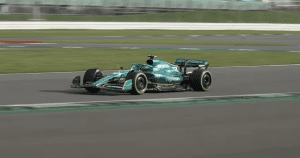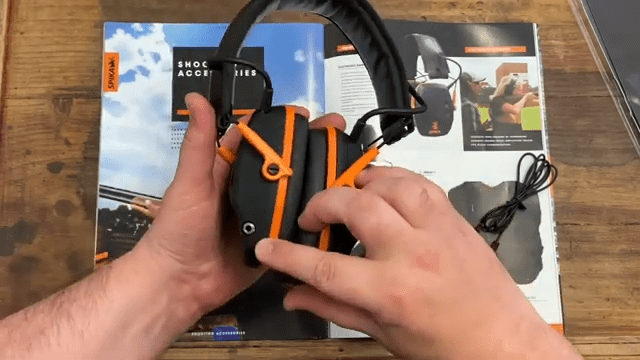Table of Contents
In the heart-pounding realm of car racing, there exists a unique pleasure that transcends the visual spectacle—listening to the driver’s radio chatter through a scanner. It is a portal into the inner workings of the race, a direct line to the strategies, triumphs, and even the setbacks experienced by the brave souls behind the wheel. Yet, a perennial adversary has persistently undermined this auditory delight: background noise. The cacophony of engines and motors has long conspired to muffle the captivating transmissions, depriving ardent race fans of an immersive experience. But fear not, for a breakthrough has emerged, promising to reshape the sonic landscape of the race track like never before.

Whether you’re a seasoned enthusiast seeking to amplify your race day experience or a curious newcomer ready to be swept away by the allure of car racing, our article will guide you through the extraordinary world of noise cancellation for race fans. Prepare to be captivated, enlightened, and invigorated as we unveil a breakthrough that ensures the roar of the race track need never drown out the exhilarating symphony of voices ever again.
The Roar’s Obstacle: Background Noise at the Race Track
Race tracks exude an ambiance that is truly unique, captivating all who venture into their midst. As the engines ignite and the cars take off, a symphony of sound ensues, enveloping the surroundings in an exhilarating audio experience. The deafening roar of engines, the screeching of tires fighting for traction, and the united cheer of the crowd create an atmosphere that resonates with palpable energy.
However, within this vibrant sonic tapestry lies a formidable challenge for race fans: background noise. The sources of this cacophony are the very elements that make the race track come alive. The powerful engines, with their roaring exhaust notes and resonating vibrations, unleash a sonic assault that can drown out even the most discerning ears. The screeching of tires as cars negotiate tight corners and push their limits further intensifies the auditory assault. And let us not forget the fervent cheers and exuberant applause of the crowd, contributing their own layer of boisterous enthusiasm to the mix.
While these elements are integral to the racing experience, they also present a hurdle for race fans trying to fully immerse themselves in the event. The sheer volume and intensity of the background noise can interfere with their ability to hear crucial communications, such as the radio chatter between drivers and their teams. The transmission of vital information, strategic discussions, and the raw emotions conveyed through these interactions can be lost amidst the overwhelming soundscape.
For race fans, this auditory obstacle implies a struggle to stay connected to the intricacies of the race. It means straining to catch the details of a driver’s message, grasping at fragments of conversation amidst the relentless roar. It’s the frustration of missing out on critical updates, thrilling overtakes, or the emotional exchanges between drivers and their crews. It’s a constant battle to piece together the puzzle of the race, trying to decipher the unfolding story while being bombarded by the encompassing noise.
Consequently, overcoming this auditory obstacle at the race track becomes paramount. It calls for innovative solutions that strike a delicate balance between preserving the inherent excitement and embracing the power of background noise, while also providing race fans with the clarity and immersion they crave. Through advancements in noise cancellation technology, such as earmuffs and earplugs specifically designed for race environments, fans can now revel in a harmonious blend of the racing symphony, ensuring that every nuance, every strategic maneuver, and every passionate exchange can be experienced with unparalleled clarity and without compromise.
Active Noise Reduction (ANR) Technology
Embedded within the relentless cacophony of the race track, the challenge of background noise persists, hindering race fans from fully immersing themselves in the intricate details of the event. However, cutting-edge technology offers a glimmer of hope in the form of Active Noise Reduction (ANR). This groundbreaking approach combats the auditory onslaught by harnessing the power of sound manipulation.
ANR operates on a principle of creating an “anti-noise” wave that counteracts the incoming noise, effectively reducing its impact on the listener. Within this realm of noise cancellation, a microphone discreetly positioned inside the earmuff’s ear cup becomes the sentinel of sound. Its keen senses capture the very essence of the surrounding noise that enters the ear.
Once the microphone captures the incoming noise, sophisticated electronics step into action. These electronics meticulously analyze the captured auditory information, discerning its characteristics and intricacies. Armed with this knowledge, the ANR system deftly crafts a precise and identical “anti-noise” wave, a sonic counterpart that is designed to be directly opposite to the incoming noise.
Through a speaker discreetly embedded within the ear cup, the “anti-noise” wave is emitted. As the “anti-noise” wave and the incoming noise intersect, they engage in a captivating dance. In this meeting of waves, the ANR system effectively neutralizes a significant portion of the background noise, resulting in a significant reduction in its overall intensity and impact on the listener.
This formidable fusion of science and engineering enables race fans to regain control over their auditory experience, allowing them to revel in the symphony of the race while minimizing the interference of background noise. With ANR technology at their disposal, fans can relish in the clarity of communication, the strategic exchanges, and the raw emotions that unfold throughout the race, amplifying their connection to the heart-pounding world of car racing.
Active Noise Reduction: Revolutionizing Race Fan Experience
Various types of ear defenders and noise-cancelling products employ Active Noise Reduction (ANR) technology to provide race fans with enhanced auditory experiences. Here are some examples of the types of products that incorporate ANR technology.
- ANR Earmuffs: Earmuffs designed for race fans utilize ANR technology to actively cancel out background noise. These earmuffs typically feature built-in microphones, advanced electronics, and speakers to deliver optimal noise reduction and audio clarity.
- ANR Earplugs: ANR technology is also integrated into earplugs designed specifically for race enthusiasts. These earplugs employ miniature microphones, electronic circuitry, and speakers to actively combat ambient noise, allowing fans to enjoy clear communication and immersive race experiences.
It is important to note that there are several reputable brands in the market that offer ANR-based ear defenders and noise-cancelling products tailored for race fans. When exploring these options, it is recommended to consider factors such as product quality, comfort, durability, and noise reduction capabilities to ensure an optimal audio experience during race events.
It is advisable to conduct thorough research and seek recommendations from fellow race fans or experts in the field to identify specific brands and products that incorporate ANR technology and best suit your personal preferences and requirements.
Earmuffs: The Race Fan’s Sonic Sanctuary
When it comes to enhancing the race fan experience, earmuffs designed specifically for race tracks emerge as a sonic sanctuary amidst the clamor. These earmuffs boast a range of features and functionalities carefully crafted to cater to the unique needs of race enthusiasts.
At the core of these earmuffs lies the transformative power of active noise reduction (ANR) technology. By intelligently analyzing the ambient noise, these earmuffs actively counteract the low-frequency engine and motor noise that pervades race tracks. This ANR capability enables fans to revel in crystal-clear audio, ensuring that every word, every communication from the drivers, resonates with unmatched clarity.
Comfort and convenience are key considerations in the design of race fan earmuffs. With adjustable fit options, fans can customize the earmuffs to securely and comfortably fit their unique head sizes. Padded ear cups offer not only a cushioned experience but also aid in isolating the sound, further enhancing the noise reduction capabilities. Additionally, these earmuffs are engineered with long-lasting battery life, allowing fans to immerse themselves in the racing world without interruption.
Earplugs: Portable Noise Shield for Race Fans
Enter earplugs, a compact and effective choice for noise cancellation that allows fans to take control of their auditory experience in a convenient manner.
Earplugs offer a remarkable ability to block out high-frequency noise, shielding the ears from the deafening roar of engines and screeching tires. However, what sets them apart is their capacity to selectively filter noise. While they effectively muffle the undesirable background noise, they still allow important sounds and communications to be heard, ensuring fans remain connected to the pulse of the race.
Different types of earplugs cater to the diverse preferences and requirements of race fans. Foam earplugs, known for their affordability and ease of use, provide excellent noise reduction by expanding to fit the shape of the ear canal. Silicone earplugs offer a reusable option, providing a comfortable and snug fit for extended wear. For those seeking a personalized experience, custom-fit earplugs can be molded to match the unique contours of an individual’s ears, delivering optimal comfort and noise reduction tailored specifically to their needs.
Implementing Different Noise Cancellation Techniques
While ear defenders and earmuffs are commonly used for noise cancellation at race events, there are alternative techniques that race fans can employ to minimize background noise and enhance their auditory experience, even without these specialized devices. Here are a few practical tips:
- Strategic Seating: Opt for seating locations away from the loudest sections of the race track. Consider choosing spots that are situated further from the starting line or the areas where the engines generate the most intense noise. By positioning yourself strategically, you can reduce the impact of the background noise on your hearing.
- Earplugs: Traditional earplugs can still be a valuable tool in reducing noise. Choose high-quality earplugs designed specifically for noise reduction and insert them properly into your ears. While they may not offer the same level of active noise cancellation as earmuffs, they can still provide a degree of sound dampening and help protect your hearing.
- Sound-Isolating Headphones: Consider using sound-isolating headphones that are designed to block out external noise. These headphones create a physical barrier between your ears and the surrounding sounds, effectively reducing the impact of the background noise. Look for headphones with good noise isolation capabilities and ensure a snug fit to maximize their effectiveness.
- Communication Devices: Utilize communication devices that allow you to tune into race commentary or driver radio transmissions. These devices often come with noise filtering features that can help you hear the important race-related audio while minimizing the impact of background noise. Explore options such as radio scanners or race-specific apps that provide real-time audio feeds.
- Personalized Equalization: Adjust the equalization settings on your audio devices to prioritize voice frequencies. By boosting the frequencies associated with human speech, you can enhance the clarity of race-related communications while reducing the impact of background noise.
While these techniques may not provide the same level of noise cancellation as dedicated ear defenders, they can still contribute to a more enjoyable auditory experience for race fans. Experiment with different approaches and find the combination of techniques that works best for you to immerse yourself in the thrilling world of car racing while minimizing the impact of background noise.
